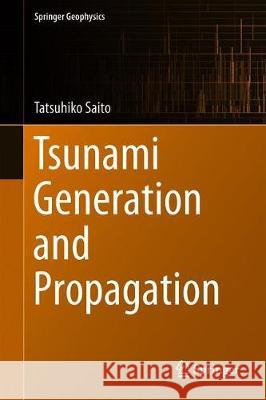Tsunami Generation and Propagation » książka



Tsunami Generation and Propagation
ISBN-13: 9784431568483 / Angielski / Twarda / 2019 / 265 str.
Tsunami Generation and Propagation
ISBN-13: 9784431568483 / Angielski / Twarda / 2019 / 265 str.
(netto: 576,41 VAT: 5%)
Najniższa cena z 30 dni: 578,30
ok. 22 dni roboczych
Dostawa w 2026 r.
Darmowa dostawa!
This book introduces a framework of tsunami modelling from generation to propagation, aimed at application to the new observation started in Japan after the devastating tsunami of the 2011 Tohoku-Oki earthquake.
Tsunami Generation and Propagation
Chapter 1 Introduction
1.1 Offshore Tsunami Observations
1.2 The 2011 Tohoku-Oki Earthquake
1.3 Observation Inside Earthquake Focal Area
1.4 Focus of this Book
Chapter 2 Overview of Tsunami
2.1 Earthquake and Tsunami: A Possible Scenario in Nankai Trough, Japan
2.2 Tsunami Generation
2.3 Tsunami Propagation
2.4 Points of Tsunami Generation and Propagation
Appendix 2A Simulation Method of Tsunami Generation by an Earthquake
Appendix 2B Phase Velocity in Nonlinear Long-Wave Equations: the First Order Approximation Method
Chapter 3 Propagation of Tsunami and Seismic Wave
3.1 Governing Equations
3.1.1 Stress and Strain
3.1.2 Equation of Motion and Constitutive laws
3.2 Tsunami: Dynamics of Incompressible Fluid
3.2.1 Fundamental Equations of Tsunami
3.2.2 Tsunami
3.2.3 Energy Density and Energy Flux Density for Incompressible Fluid
3.3 Seismic Wave: Elastic Dynamics
3.3.1 P, S, and Rayleigh Waves
3.3.2 Ocean Acoustic Wave
3.3.3 Energy Density and Energy Flux Density for Elastic Medium
3.4 Waves in Continuum Medium
Chapter 4 Earthquake
4.1 A Point Source and Seismic Wave Excitation
4.1.1 A Point Shear Dislocation Source: Equivalent Body Force and Moment Tensor
4.1.2 Displacement Field form a Point Source
4.2 Finite Fault Model and Scaling Law
4.2.1 Stress Drop
4.2.2 Scaling Law
4.3 Seismic Wave Simulation
4.3.1 Finite Difference Method
4.3.2 Seismic Waves, Ocean Acoustic Waves, and Permanent Displacement
4.3.3 Bridging Seismic Wave Simulation to Tsunami Propagation Simulation
Appendix 4A Seismic Wave Propagation in 2-D Space: P-SV Problem
Chapter 5 Tsunami Generation
5.1 Ocean Acoustic Wave and Tsunami: Different Driving Forces
5.2 Linear Potential Theory
5.2.1 Governing Equations
5.2.2 Solving Laplace Equation with Boundary Conditions
5.3 Generation
5.3.1 Visualization
5.3.2 Analytical Solutions
5.3.3 Pressure Change
5.4 Bridging Generation to Propagation5.4.1 Contribution of Sea-Depth Variation
5.4.2 Synthesis of Ocean-Bottom Pressure Record
Appendix 5A Equation (5.28)
Appendix 5B Tsunami Propagation from an Initial Height Distribution and Zero Velocity Distribution
Chapter 6 Propagation Simulation
6.1 Nonlinear and Dispersive Tsunami6.1.1 Nonlinear Wave
6.1.2 Dispersive Waves
6.2 Tsunami Equations Derived from Equation of Motion
6.2.1 Integration with Respect to Sea Depth: 3-D to 2-D equations
6.2.2 Long-Wave Approximations6.3 Numerical Simulations: Finite Difference Method
6.3.1 Linear Long-Wave Equations: Simplest Equations
6.3.2 Nonlinear Long-Wave Equations: Inundation6.3.3 Linear Dispersive Equations: Deep Ocean
6.3.4 Nonlinear Dispersive Equations
Chapter 7 Epilogue
7.1 Tsunami Propagation
7.2 Tsunami Generation
7.3 Earth Science and Disaster Prevention
Tatsuhiko Saito received a Ph.D. at Tohoku University, Japan in 2003, where he studied scattering theories for applications to and interpretations of high-frequency seismograms. After graduation, as a postdoc researcher he continued to work on the investigation of seismic-wave propagation through heterogeneous earth at the National Institute of Advanced Industrial Science and Technology, and extended his research interests to seismic and tsunami generation using high-performance computing techniques on supercomputers at the Earthquake Research Institute, The University of Tokyo. He then moved to the National Research Institute for Earth Science and Disaster Prevention (NIED) (the present National Research Institute for Earth Science and Disaster Resilience) in 2010 and has been working there since as chief researcher. Following the 2011 Tohoku-Oki great earthquake, the NIED has started a new observational project, deploying more than 150 online seismic/tsunami sensors off the Pacific coast of eastern Japan to detect tsunami generation inside the focal area. He is currently engaged in research for the generation of earthquakes and tsunamis.
This book introduces a framework of tsunami modelling from generation to propagation, aimed at application to the new observation started in Japan after the devastating tsunami of the 2011 Tohoku-Oki earthquake. About 150 seismic and tsunami sensors were deployed in a wide region off the Pacific coast of eastern Japan in order to catch tsunami generation inside the focal area, which makes a clear departure from conventional observations that detect tsunamis far from the source region. In order to exploit the full potential of this new observation system, it is not enough to model tsunami generation simply by static sea-bottom deformation caused by an earthquake. This book explains dynamic tsunami generation and sea-bottom deformation by kinematic earthquake faulting, in which seismic and acoustic waves are also included in addition to static sea-bottom deformation. It then systematically derives basic tsunami equations from the fundamental equations of motions. The author also illustrates the details of numerical schemes and their applications to tsunami records, making sound linkages among these topics to naturally understand how a tsunami is physically or mathematically described. This book will be a comprehensive guide for graduate students and young researchers to start their research activities smoothly.
1997-2025 DolnySlask.com Agencja Internetowa
KrainaKsiazek.PL - Księgarnia Internetowa









